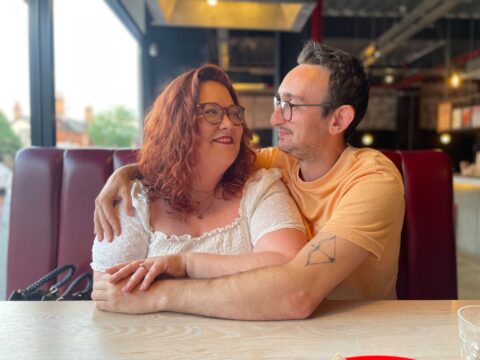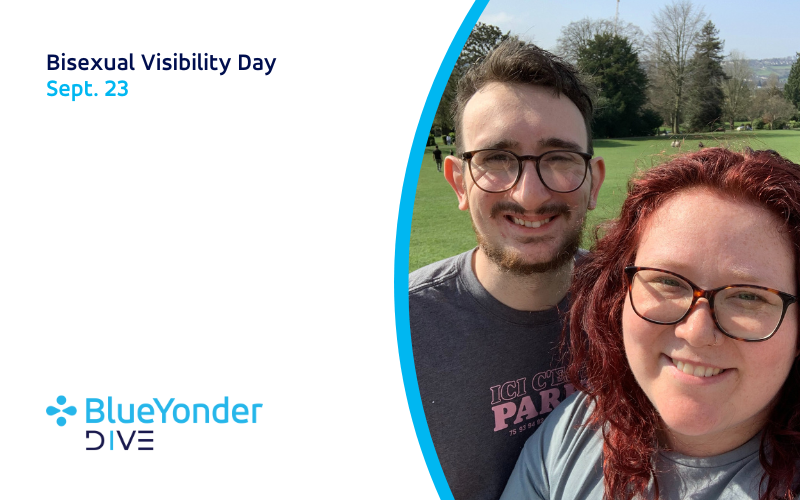Undercover Bisexual: Being a Queer Person in a Heterosexual-Presenting Partnership
Bisexual Visibility Day is Sept. 23 and is celebrated as part of Bisexuality Awareness Week. Both aim to raise awareness of bisexual identities and the cultural acceptance of bisexual people within society. Blue Yonder associate Maddi Cook shares her experience of navigating her bisexual identity alongside her hetero-appearing relationship.
I am engaged to a wonderful person. Funny, smart, caring. Drives me nuts. Lights up a room. The only problem? He is a man.
Of course, that is not a problem at all, not really. But sometimes it can feel like a bit of a prickly subject for a bisexual woman. Since I was young, I have known that I am bisexual. It was a label that came easily to me. When I heard it, I was in a privileged enough position to think “Yep, that’s me!” and to adopt it and use it with minimal pushback from my social circle.
Finding the words to express who I am and who I love was the easy part — the harder part came when I had to defend that identity later in life.

I had resistance from the queer community, both people I knew and people I didn’t, declaring bisexuality “not real” — rather, just a first stop on the way to fully gay. I don’t really mind the label being used as a friendly checkpoint, as a lot of people do find it easier in the exploration of their identity to come out to friends and family as bisexual before embracing or discovering their truth. However, what did bother me was people erasing it as an identity altogether. There was even an online movement behind Pride 2024 to ban straight partners of queer people. The very conception of Pride was necessitated by inclusivity and human rights, and I found it entirely disrespectful and hypocritical for a community of which I am a part to try and exclude the person I love. I am real, my experience with attraction and sexuality is valid, and although it may not be an entirely equal 50/50 split of attraction, I believe it is enough to qualify me as authentically queer, and my partner should be allowed to celebrate alongside me.
I also encountered resistance from the straight community. This was to be expected for the first child in my families to come out (as far as I know). I came out after a particularly painful attack against the LGBTQ+ community and felt compelled to share my identity with my parents and wider family, who tentatively accepted it (but in typical English fashion, rarely talk about it). Some people asked me why it mattered to me to come out — I was with my partner for around five years, and happy — or that it was “just a phase” and lots of people go through it. It was frustrating for me and my experience to be consistently invalidated or diminished by my loved ones, and in some dark moments I found myself questioning why I had bothered coming out at all.
There has also been a lot of debate around the ethics of bisexuality recently. Being bisexual was incorrectly branded as unethical — as it assumed that it was attraction to only men or women, and not any other gender — and instead the “correct” ethical identity was pansexuality, which is attraction to all genders. In reality, bisexuality is defined as being attracted to any more than one genders — men, women, non-binary people, genderfluid people, and all the other genders in between. You may think of this as pedantic, and perhaps it is, but I think this narrative was born out of fear of people isolating vulnerable members of the community even further. Gladly, that is not the case, but it does mean that once again, the bisexual community has been demonised for their attraction, even within the LGBTQ+ community.
As a part of this, there was very rarely any media representation. This means that bisexuality wasn’t part of the cultural zeitgeist and there was nothing to combat the misconceptions listed above. I think the only bisexual-adjacent piece of content that was from my generation, was I Kissed a Girl by Katy Perry, and that was by an artist who famously was married to men! No knowledge was imparted by representation prompting people to do their research or confront their — at best, confused and at worst, prejudiced — feelings, and therefore ignorance of the community was transferred to real people, like myself. Although this may not have been intended to be hurtful, it often was.
All of this brought forth a new wave of negative feelings around my identity — guilt for not protecting my partner, shame for not being enough for either community, confusion for why I was being so scrutinised. Why did I bother coming out when I am in a hetero-presenting relationship? Was I being selfish to ask people to adapt their perception of me as a person or for asking them to accept my fiancé as a part of that identity?
What got me out of this funk was time. I realised that being my authentic self is not a negative thing — in fact, it makes the world more interesting! The media perception also started to shift, helped by representation such as Stephanie Beatriz (Rosa in Brooklyn99 and Mirabel in Encanto), Ramona Royale in American Horror Story, Magnus Bane in Shadowhunters, Lucifer Morningstar in Lucifer and more. Helped by the support of my fiancé, best friends and the love and acceptance of my son, I slowly came to terms with my identity and pushed back against the harmful narratives I encountered. I have raised my son to recognise that any two adults can fall in love with each other, and knowing that he is part of a society which has representation and prioritises tolerance gives me faith that his generation will not have to defend themselves or their sexuality the way I did.

